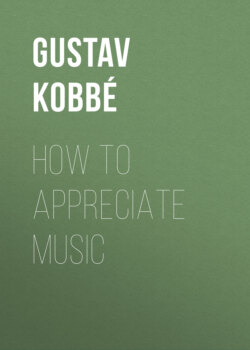Читать книгу How to Appreciate Music - Gustav Kobbé - Страница 8
На сайте Литреса книга снята с продажи.
Its Lowly Origin.
ОглавлениеIt must not be supposed, however, that the instrument as we know it attained to its present supremacy except through a long process of evolution. One of the immediate precursors of the modern pianoforte was the harpsichord, a name suggesting that the instrument was a harp with a keyboard attachment, and such, in a general way, the pianoforte is. But the harp is 38 a very fully developed affair compared with the mean little apparatus in which lay and was discovered many centuries ago the first germ of the king among instruments. This was the monochord, and it has required about nine centuries for the evolution of an instrument consisting of a single string set in vibration by means of a keyboard attachment into the modern pianoforte. But do not be alarmed. I am not about to give a nine hundred years’ history of the pianoforte. Such detailed consideration would belong to a technical work on the manufacture of the instrument and would be out of place here. Something of its history should, however, be known to every one who wants to understand music, but I shall endeavor to be as brief and at the same time as clear as possible.
The monochord originally was used much as we use a tuning fork, to determine true musical pitch. If you take a short piece of string, tie one end of it fast, draw it taut and pluck it, its vibrations will sound a note. If you grasp the string and draw it taut from nearer to the point where it is tied, you shorten what is called the “node,” increase the number of vibrations and produce a higher note. The monochord in its simplest form consisted of a string drawn taut over an oblong box and tuned to a given pitch by means of a peg. Under the string and in contact with it was a bridge or fret that could be moved by hand along a graduated scale marked on the bottom of the box. By moving the bridge the node of the string could be shortened and the notes marked at corresponding points on the graduated scale produced. After a while, and in order to facilitate the study of the harmonious relationship between 39 different notes, three strings were added, each with its bridge and graduated scale.
It was more or less of a nuisance, however, to continually shift four bridges to as many different points under the four strings. As an improvement upon this awkward arrangement some clever person conceived about the beginning of the tenth century, the idea of borrowing the keyboard from the organ and attaching it to the monochord. To the rear end of each key was attached an upright piece called a tangent. When the finger pressed upon a key the tangent struck one of the strings, set it in vibration, and at the same time, by contact, created a node which lasted as long as the key was kept down and the tangent remained pressed against the string. To increase the utility of the instrument by adding more strings and more keys was the next obvious step, and gradually the monochord ceased to be a mere technical apparatus for the determining of pitch and became an instrument on which professionals and amateurs could play with pleasure to themselves and others.
